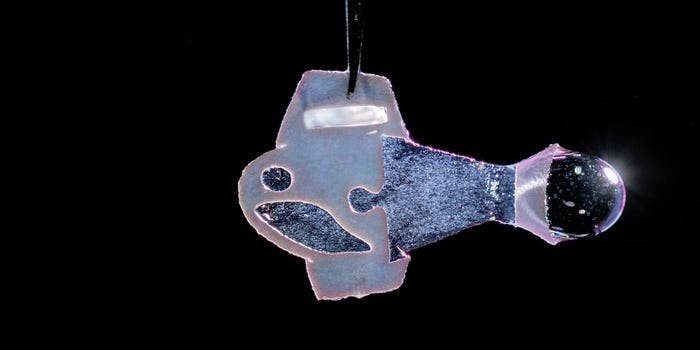
Researchers have devised a biohybrid mechanical fish that can swim using a tailfin that flips from side to side, powered by human heart muscles grown in the lab. This strange-looking robot was able to swim to the beat of a heart for more than 100 days, and scientists hope to leverage these experiments to someday grow fully functioning human hearts for transplant.
Thousands of Americans are on the waiting list for a heart transplant, but only 55% receive one in time. And those who are lucky enough to get a transplant face the major risk of their bodies rejecting the new heart. Growing a new heart from scratch in the lab can solve both the shortage and biocompatibility problems since the transplanted organ would be grown from a patient’s own cells.
Easier said than done, though. Scientists across the world have devised all sorts of methods to grow lifelike heart models. Past studies have used a technique known as tissue engineering, in which heart cells are grown onto artificial support frames akin to building a house out of brick and mortar. However, although these tiny heart models promisingly look like developing hearts, they fail to mimic the physiological response of a healthy human heart.
The researchers at Harvard and Emory University took up the challenge of growing tissue that not only looks like a heart, but beats like one too. They built upon previous research in which a team from the University of Illinois devised a soft robot shaped like a stingray whose swimming movements were powered by over 200,000 bioengineered rat heart cells known as cardiomyocytes, activated by light.
This time, the cardiomyocytes were derived from human stem cells, which the researchers lined each side of the biohybrid fish’s tail fin with. Each time a muscle tissue contracted or stretched, it opened up ion channels, triggering the opposite motion to follow. The mere action of physical bending is what triggers the muscles to activate and contract.
As such, the artificial fish is completely autonomous, as it can self-perpetuate its own movements independent of any external stimuli. That’s exactly how the human heart functions too, receiving minimal instructions from the brain.
“By leveraging cardiac mechano-electrical signaling between two layers of muscle, we recreated the cycle where each contraction results automatically as a response to the stretching on the opposite side,” said Harvard University bioengineer Keel Yong Lee.
“The results highlight the role of feedback mechanisms in muscular pumps such as the heart.”
Over time, the tail wagging weakened but after the researchers introduced a pacemaker that releases regular electrical pulses, the artificial fish kept swimming for more than 100 days.
“Because of the two internal pacing mechanisms, our fish can live longer, move faster, and swim more efficiently than previous work,” explains biophysics researcher Sung-Jin Park, co-first author of the study that appeared in the journal Science.
The ultimate goal is to take these lessons to make an artificial, self-pulsing muscle that could replace parts of a damaged human heart; for instance, to repair the organ after a heart attack. However, the technology is still a long way from making its way into the operating room. Growing hearts from scratch for transplants is an even more distant dream.
But although this kind of research is still in its infancy, the results so far are very promising.
“Our ultimate goal is to build an artificial heart to replace a malformed heart in a child,” said Kit Parker, senior author of the study. “Most of the work in building heart tissue or hearts, including some work we have done, is focused on replicating the anatomical features or replicating the simple beating of the heart in the engineered tissues. But here, we are drawing design inspiration from the biophysics of the heart, which is harder to do. Now, rather than using heart imaging as a blueprint, we are identifying the key biophysical principles that make the heart work, using them as design criteria, and replicating them in a system, a living, swimming fish, where it is much easier to see if we are successful.”









